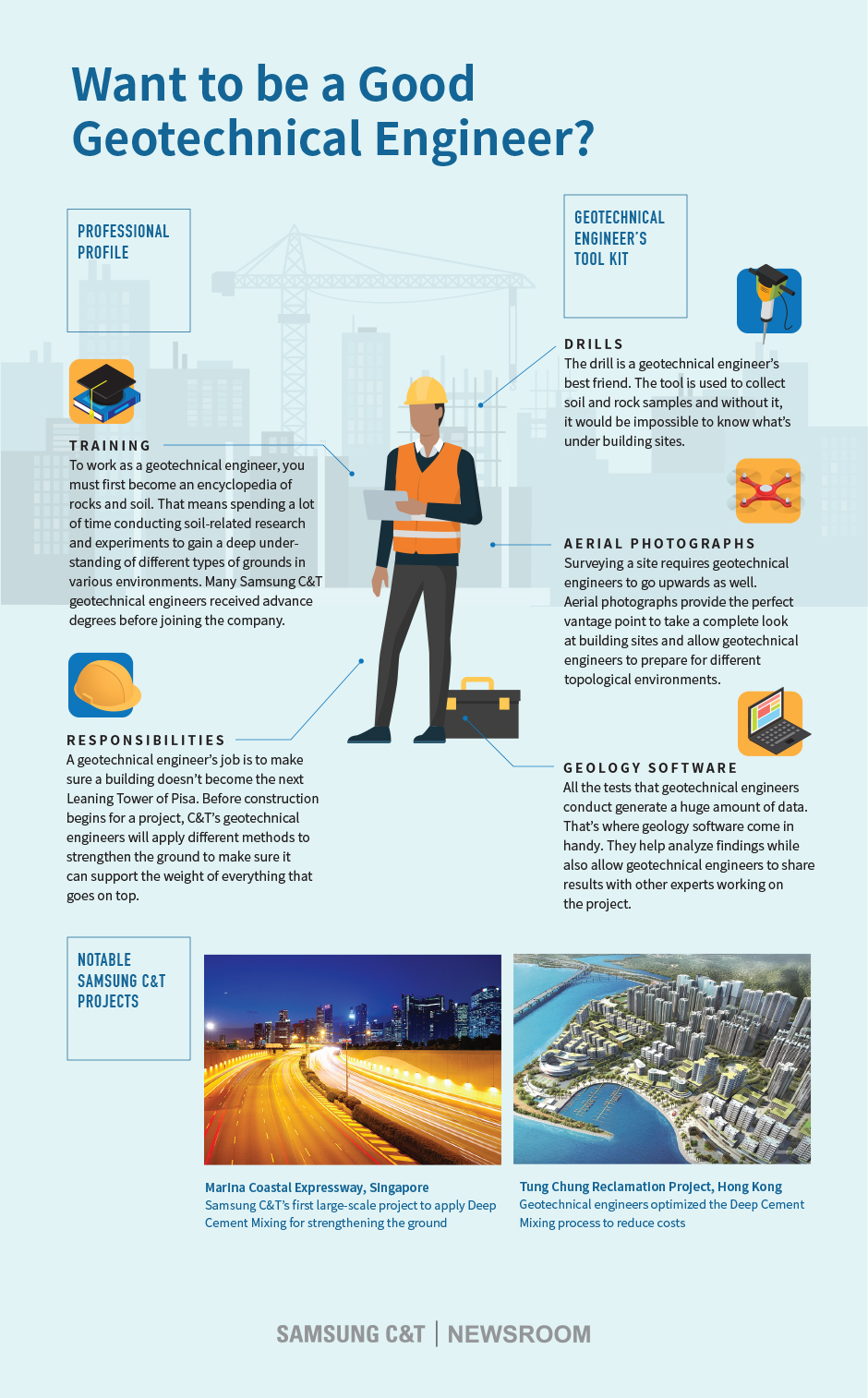Some Ideas on Geotheta You Need To Know
Some Ideas on Geotheta You Need To Know
Blog Article
The Best Guide To Geotheta
Table of ContentsGeotheta - The FactsAll About GeothetaSome Known Details About Geotheta The 2-Minute Rule for GeothetaThe 15-Second Trick For Geotheta

They carry out website examinations, accumulate examples, carry out research laboratory tests, and evaluate data to review the suitability of the ground for building projects - Geotechnical Engineers. Based on their findings, geotechnical designers provide suggestions for structure design, incline stability, retaining frameworks, and mitigation of geotechnical risks. They collaborate with various other professionals, such as designers, architectural designers, and building and construction groups, to make certain that geotechnical factors to consider are integrated into the general task layout and implementation
By evaluating the actions and homes of soil and rock, they can determine potential geotechnical risks such as landslides, dirt negotiation, or slope instability. Their expertise assists prevent failures or accidents that could threaten lives and residential or commercial property. Here are some thorough duties and responsibilities of a geotechnical designer: Website Examination: Geotechnical engineers conduct site examinations to collect information on subsurface conditions.
They translate the information to understand the properties and habits of the dirt and rock, including their toughness, permeability, compaction qualities, and groundwater conditions. Geotechnical Analysis and Style: Geotechnical engineers assess the information gathered during site investigations to examine the security and suitability of the website for building and construction tasks. They execute geotechnical calculations and modeling to review factors such as bearing ability, negotiation, incline security, side planet stress, and groundwater circulation.
See This Report on Geotheta
Foundation Style: Geotechnical designers play a critical function in making foundations that can securely support the designated framework. They examine the soil problems and load requirements to figure out the suitable foundation type, such as superficial structures (e.g., footings), deep foundations (e.g (https://www.find-us-here.com/businesses/Geotheta-Alexandria-Alabama-USA/34113488/)., piles), or specialized methods like dirt improvement. They take into consideration aspects such as negotiation restrictions, birthing capability, and soil-structure communication to establish optimal structure designs
They examine construction strategies, monitor site activities, and conduct area examinations to validate that the design suggestions are complied with. If unexpected geotechnical issues emerge, they analyze the scenario and provide suggestions for removal or changes to the design. Risk Assessment and Reduction: Geotechnical engineers analyze geotechnical hazards and threats associated with the task website, such as landslides, liquefaction, or soil erosion.

Cooperation and Interaction: Geotechnical engineers function closely with other professionals associated with a project, such as designers, architectural designers, and construction groups. Efficient interaction and collaboration are necessary to incorporate geotechnical factors to consider right into the total job style and building process. Geotechnical designers supply technical expertise, response inquiries, and guarantee that geotechnical needs are fulfilled.
Geotheta - An Overview
Here are some types of geotechnical engineers: Foundation Engineer: Structure designers specialize in making and assessing foundations for structures. They evaluate the dirt conditions, load needs, and site characteristics to determine the most suitable foundation kind and layout, such as superficial structures, deep foundations, or specialized techniques like pile foundations.
They review the aspects influencing incline stability, such as dirt residential properties, groundwater conditions, and incline geometry, and establish techniques to avoid slope failures and mitigate risks. Earthquake Engineer: Earthquake engineers focus on analyzing and developing structures to withstand seismic pressures. They assess the seismic threat of a site, evaluate soil liquefaction possibility, and create seismic style criteria to make sure the safety and strength of frameworks throughout quakes.
They carry out area testing, accumulate samples, and evaluate the gathered information to define the soil properties, geologic formations, and groundwater conditions at a website. Geotechnical Instrumentation Engineer: Geotechnical instrumentation designers focus on tracking and measuring the habits of dirt, rock, and structures. They mount and maintain instrumentation systems that check aspects such as soil negotiation, groundwater degrees, incline movements, and structural displacements to examine efficiency and provide very early warnings of potential issues.
Geotheta for Dummies
They carry out examinations such as triaxial examinations, consolidation tests, direct shear tests, and leaks in the structure examinations to gather information for geotechnical analysis and style. Geosynthetics Engineer: Geosynthetics engineers concentrate on the layout and application of geosynthetic products, such as geotextiles, geogrids, and geomembranes. They use these products to improve dirt stability, reinforce inclines, supply drainage services, and control disintegration.
They tend to be investigatory individuals, which means they're intellectual, introspective, and inquisitive. They are curious, systematic, logical, analytical, and rational. A few of them are also social, meaning they're kind, generous, cooperative, patient, caring, valuable, compassionate, sensible, and pleasant. Does this seem like you? Take our free profession test to figure out have a peek here if geotechnical engineer is just one of your leading profession suits.
In the office setting, geotechnical engineers use specialized software program devices to do estimations, develop styles, and examine data. They prepare records, review job requirements, communicate with customers and employee, and coordinate project activities. The office setup gives a conducive atmosphere for research, evaluation, and cooperation with various other experts associated with the task.
Our Geotheta Ideas
They frequently see task sites to perform website investigations, examine geotechnical problems, and collect information for evaluation. These gos to entail taking a trip to different places, sometimes in remote or difficult surfaces. Geotechnical designers may do dirt sampling, conduct tests, and screen construction tasks to guarantee that the geotechnical facets of the task are being implemented appropriately.
Geotechnical designers likewise work in specialized geotechnical labs. In these centers, they conduct experiments, execute tests on dirt and rock examples, and evaluate the design residential or commercial properties of the products. Geotechnical laboratory designers work extensively in these atmospheres, managing screening tools, running instruments, and tape-recording information. They team up with various other lab personnel to make sure precise and reputable testing results.
Report this page